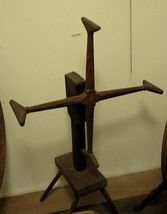There was a time when if you needed butter, you milked the family cow and churned it yourself.
Clothing was made from sheep’s wool, spun on a wheel and woven or knitted. Light came from kerosene lamps. While it may be difficult to imagine such a life, there are places that keep that past alive.
One such place is the Esperance Historical Museum, a treasure trove of artifacts, information, and memories. It opened in 1970 with Fred Lape, founder of the Landis Arboretum, as its first curator. Many individuals have since contributed time and effort in its planning and construction, including Ed Fuse and artist Gus LaMonica. The current president (since 1978) is Ken Jones, a very knowledgeable man with an encyclopedic memory. The museum consists mainly of three buildings, the schoolhouse, the chapel, and the carriage barn.

The main building is the schoolhouse, dedicated in 1878 and used for grades one through eight. It continued operation of a kindergarten through third grade until 1968. It now houses many exhibits of the way things were. It now houses items from the schoolhouse and a local doctor’s office. There is a display featuring the making of baseballs, a common occupation for the ladies of Esperance including Emma Lape, Fred’s mother. In a corner are many uniforms and other mementoes of World Wars 1 and II. Household items are featured including a wooden cradle and items used to process yarn. One of these, called a weasel, is a 4‑armed spinner on a stand used to wind and measure yarn. When a full skein had been wound after a certain number of revolutions, it made a popping sound — hence “pop goes the weasel.” Also on exhibit are many examples of toys, miniatures, and folk art.
Attached to the schoolhouse is a replica of the Esperance Cemetery chapel. The original was erected in 1902 for spring burials. In 2011, as it was being readied for transport to the museum, it was destroyed by the floods of Hurricane Irene. Using as much of the original as possible, the copy was erected and dedicated in June 2014. It’s used as a meeting room and library, housing many historical books and documents, including all of Fred Lape’s books and poetry pamphlets.
Nearby is the carriage house, a large enclosed building housing many articles too large for the schoolhouse. It contains small equipment ranging from a cream separator to large wooden horse-drawn farm implements. Whenever possible, machines produced in Esperance or the surrounding area are obtained for the collection.
The museum is located at 123 Church Street, just off Route 20 in Esperance, NY. It is open Memorial Day to Labor Day weekends (Saturday and Sunday), 1 to 4 p.m. Admission is free, but donations are gratefully accepted. A volunteer is on hand to assist.
One visit isn’t enough to fully appreciate all the museum has to offer. Take time to not only see, but appreciate the use and context of each item. You may find your heart urging you to help sustain this institution. Volunteers in any capacity are always valued. The Esperance Historical Museum Facebook page has further information, including events and contact specifics.
